RAF Hawkinge and the Kent Battle of Britain Museum
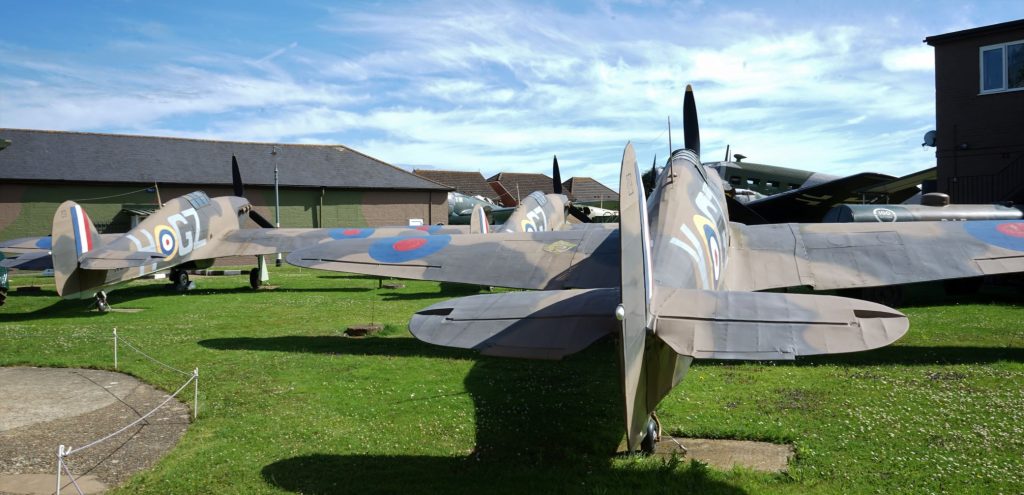
It was a short train ride from Ashford to my new base at Folkestone, and with a few hours to kill before I could check in to my accommodation, I headed to the town’s clifftop promenade. The weekend’s rainy weather had finally cleared, and a wan sun shone over the town. I sat on a bench munching a sandwich as a steady flow of walkers passed by. I overheard one lady say to another ‘Ooh I’m thirsty today. You have to keep hydrated in this weather’. I checked the current temperature on the phone and smiled to myself: 17 degrees.
Looking out from the cliffs at Folkestone, I could make out the coast of France. Seeing for myself how narrow the Channel is at this point, it was easy to understand why this part of England was the ‘front line’ during the Battle of Britain. In 1940, No. 11 Group, RAF Fighter Command, was responsible for the south-east coast of England, and one of its airfields was RAF Hawkinge, less than five kilometres north of Folkestone.
A couple of days after arriving at Folkestone I caught the bus to what was once RAF Hawkinge. Walking from the bus stop to the site, I wondered if had the address wrong. I was in the middle of neat and tidy suburbia, with red brick semi-detached houses lining the streets. I knew that most of Hawkinge Aerodrome had been developed since the land was sold by the RAF in 19641, but I still couldn’t reconcile the area around me with a World War II airfield. But sure enough, turning a corner I saw the entry to the Kent Battle of Britain Museum. Walking through the gates, it occurred to me that it was the 10th of July, 84 years to the day since the Battle of Britain had begun.
I was welcomed by a couple of staff members at the small ticket office and gift shop. As I paid my entrance fee, one of the volunteers explained that photography was not permitted inside the Museum. This was due to both security reasons (other aviation Museums had been broken into and had items stolen, and staff had reason to believe that the Kent Battle of Britain Museum may have been ‘cased’), and the wishes of those who had donated items to the collection. Having read about the photography ban on the Museum’s website, I had brought a pad and pen to make some notes, something that is encouraged by the management.
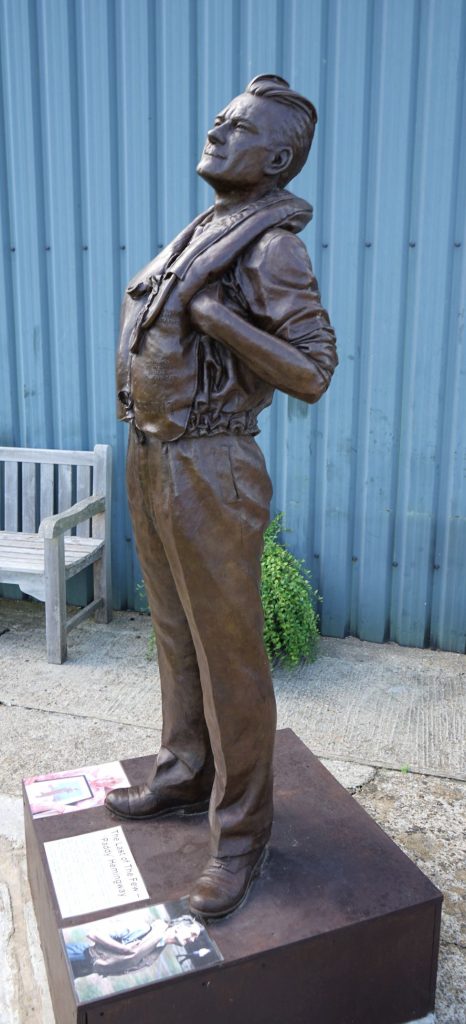
Making my way through the gift shop I stepped out into the Museum grounds. To my left, three replica Hurricanes stood on the lush green lawn in the bright sunshine.
Standing by the path on the way to the first exhibit hall, the ‘Stuart-Buttle Hangar’, was a brass statue of an airman. His hands tucked inside his life jacket, he leans back, eyes up to the sky. The pilot is Group Captain John Hemingway DFC AE.
(At the end of my visit, I was permitted to take photographs in the Museum grounds)

John Allman Hemingway was born in Dublin, and joined the RAF before the outbreak of WWII. Group Captain Hemingway flew Hurricanes with No. 85 Squadron RAF during the Battle of Britain. Accredited with two aerial victories in May 1940, he was himself shot down twice during the Battle. Gp Cpt Hemingway remained with the RAF after the war, retiring in 1969.2
‘I don’t think we ever assumed greatness of any form…We were doing a job we were employed to do. We just went up and did the best we could…Every day, off you went. When you took off you knew some of you would come back – and some of you wouldn’t…I was shot down many times but I’m still here. So many others were shot down first time and that was the end of them. I was lucky. And I’m still lucky‘. Grp Cpt John Hemingway3
‘Paddy’ Hemingway is the last known surviving airman from the Battle of Britain; the ‘Last Of The Few’. He lives in Dublin, Ireland, and will turn 105 this year.
Entering the Hangar, a small sign had been posted just inside the door, listing some facts and statistics regarding the Battle of Britain. The sign may have been a simple black and white laminated sheet, but its contents were striking.
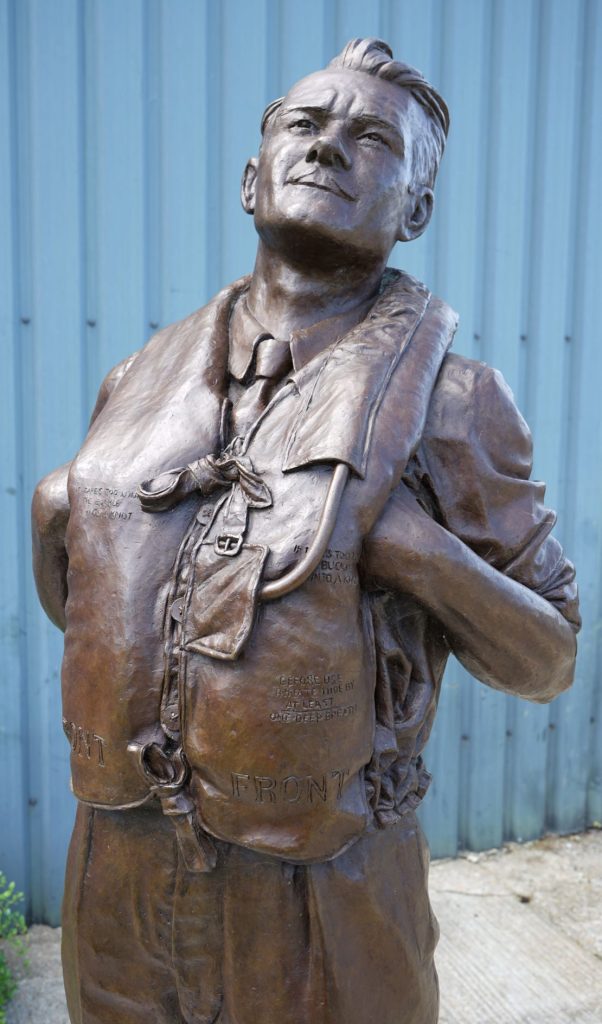
From the 10th July to the 31st of October, 2938 Allied airman had flown at least one sortie during the Battle of Britain, 544 of which were killed or died of wounds: nearly 20 percent, or one in every 5, of those who flew. (A further 422 were wounded, meaning one in three airmen became casualties4). The Museum information also stated that 2698 members of the Luftwaffe were killed over the course of the Battle.
The Stuart-Buttle Hangar was crammed full of aircraft, vehicles, artefacts, and a series of engines recovered from crash sites. The complete aircraft on display were replicas, many of which had been used in the 1969 movie The Battle of Britain. One of the staff members later told me that some of the ‘aerodrome’ scenes in the movie had been filmed at Hawkinge.
One of the many engines on display had been recovered from a Spitfire crash site in 1971. The force of the crash had twisted the Rolls Royce Merlin Mk III’s V12 along its longitudinal axis, squashing its exhaust ports like empty plastic milk bottles. The engine had belonged to Mk I Spitfire R6713 of No. 65 Squadron RAF. Flying Officer Franciszek Gruszka was flying R6713 on the 18th of August, 1940.
Fellow No. 65 Squadron pilot Flying Officer Jeffrey Quill stated ‘The 18th August was a hectic day, and once combat was joined, our two Poles were inclined to go chasing off on their own, so determined were they to get at the enemy. Gruszka sadly failed to return from our lunchtime engagement over Kent, and as we received no reports of any Spitfires having crashed inland, assumed that he must have crashed into the sea’.5
Flying Officer Franciszek Gruszka was born in Lwow, Poland, and graduated from the Polish Air Force ‘School of Eagles’ in 1934. After flying against the Luftwaffe during the invasion of Poland F/O Gruszka escaped to England, arriving in December 1939. He was assigned to No. 65 Squadron RAF flying Spitfires. He was 30 years old when he was killed on 18th August 1940, his remains being recovered during the excavation of his aircraft in 1971. F/O Gruszka is buried at Northwood Cemetery in Middlesex.6

‘To die here is very easy and sooner or later the same thing is waiting for me…tell my family…that I fought for freedom of our Homeland and fulfilled my obligation. I loved it the best I could, and if I gave my life, I gave it for your life and the whole generations…‘ F/O Franciszek Gruska, letter to a friend, August 19407
Walking along the rows of exhibits, I stopped at a photo that was taken outside the Officer’s Mess at Tangmere Aerodrome (located on the outskirts of Chichester, West Sussex) on the 7th of September, 1940. Five pilots of No. 43 Squadron are in deck chairs, with a further three airmen standing behind leaning on the seat frames. It’s a sunny day, and the pilots look relaxed as they smile at the camera. The Museum information accompanying the photo stated that two of the pilots, Flight Lieutenant Dick Reynell and Squadron Leader Caesar Hull, were killed ‘…within three hours of this photograph being taken’.

Squadron Leader Caesar Barrand Hull was born in Southern Rhodesia, and moved to England to join the RAF in 1935. During the Battle of Britain, he took command of No. 43 Squadron RAF on 31st August 1940. Flying a Hurricane, Sqn Ldr Hull destroyed three enemy aircraft within a week. He died after being shot down over south London on September the 7th. 8

Lieutenant Richard Carew Reynell was born in Reynella, South Australia. He travelled to England to attend Oxford University, where he joined the University Air Squadron before transferring to the RAF in 1931. He later left the RAF for a stint as a test pilot (during which he remained a RAF reservist), before re-joining at the outbreak of the war. Lt Reynell was assigned to No. 42 Squadron RAF, flying Hurricanes, in late August 1940. During the Battle of Britain he was credited with one aerial victory and several ‘probables’. He was killed on the 7th of September during combat over south London.9
Turning from the photo, I looked at the line of engines in the display hall. Taking a couple of steps, I glanced into the adjoining hangar, to see more engines, and rows of cabinets filled with artefacts from crash sites. Most museums aim to educate and inform visitors with a representative sample of items pertaining to a particular theme. It appeared that the Kent Battle of Britain Museum had, conversely, committed to presenting information about, and artefacts from, as many Battle of Britain airmen and aircraft as they had space to display. Despite having just arrived, I already knew I was going to run out of time before I could see all the exhibits.
Within the Museum’s second display hall, the Lord Dowding Memorial Hangar, a series of large photographic portraits of older gentlemen overlooked the relatively intact remains of a crash-landed Messerschmitt Bf-109. In his photograph, Squadron Leader Tony Pickering is wearing overalls and standing in a large vegetable garden, whilst Flying Officer Kenneth Wilkinson is leaning on a putter on a practice green. Flight Lieutenant Albert Gregory has his hands in his pockets, standing outside a red brick unit with a tidy garden. Air Commodore Peter Brothers is standing on a neatly mowed lawn smoking a cigar. Flight Lieutenant Keith Lawrence sits with his hands out flat on a desk next to a small model of a Spitfire. He has long fingers which remind me of my father’s. The photographs are candid and compelling. As I looked up at the faces of these men, I couldn’t help but wonder how their wartime service affected them over the course of their long lives. Being part of the Battle of Britain legend, I also wondered how much attention they received from the public, and how they felt about it, particularly as the years passed and the survivors were increasingly lionised.
Mounted in one of the Museum’s display cases was a gramophone record. On the fourth day of the Battle of Britain, BBC journalist Charles Gardener had made a live recording from the White Cliffs of Dover. Gardner reported the action in real time as a German raid on Channel shipping developed into a ‘dogfight’ with the RAF overhead. Later, I found the same recording online.
The recording is a unique eye-witness account of what would become a familiar sight to the people of Kent over the following months. There has been criticism of Gardener’s account, including that the RAF aircraft were not Spitfires but Hurricanes. Further, the aircraft shot down in flames as described by Gardener was in fact Hurricane L1584 of No. 615 Squadron, flown by Pilot Officer Michael Mudie. (The two surviving Hurricanes of 615 Squadron’s Red Section landed at Hawkinge after the action.10) Considering the height, speed and chaos of aerial fights, it’s not surprising that such mistakes were made. As Gardner states later in the recording: ‘…you can’t watch these fights very coherently for long you just see about four twirling machines and you hear little bursts of machine guns and by the time you’ve picked up the machines…they’ve gone.’

Pilot Officer Michael Robert Mudie was born in Singapore, and joined the RAF in March 1939. He served with No. 615 Squadron, flying Hurricanes, during the Battle of Britain. Shot down off Dover on July 14th, P/O Mudie parachuted into the Channel where he was picked up by the Royal Navy. He died of his wounds the following day, aged 24.11
Amongst the aluminium and steel artefacts displayed at the Kent Battle of Britain Museum were many personal effects. One display presented items belonging to Sergeant Edward Egan, who was posted to No. 501 Squadron, RAF Kenley, in September 1940. They included a copy of a letter written to his mother dated 14th of September.
Dear Mum,
Sorry I have been so long in writing; but we have kept pretty busy lately…
…two or three hours ago I had to stop writing this letter as we had to rush off to intercept some Jerry bombers making for London. I shoved the letter in my pocket, so it came along with me. We met the bombers at about 15,000’ on their way. They were coming head on so most of us put our noses straight up in the air as we were below them and sent up a barrage of bullets for them to fly through…
Suddenly somebody shouted ‘look-out’, so we split up and dived away once again. I went down about 3000 ft and had just levelled out, when I spotted an Me 109 with a bright yellow nose diving for a cloud. Just as I got onto his tail, he banked left, but as a Hurricane can turn faster, I got in a quarter attack with a 4 second burst. He then turned for another cloud, but I got in another burst of 5 seconds before he reached it. I then went in the cloud after him. As I came out…about 500 yds in front was what looked like an Me 109 going down in flames with a parachute coming down a little higher up…
Well I have been writing this letter in bits for three days now which accounts for its dirty appearance…
Please wish Dad many happy returns for me. I am very sorry I haven’t been able to buy him a present; but we haven’t been able to leave camp since we arrived, we’ve been so busy. Tell him I will get him a birthday present when I come home next. We will be able to have a lay in till 08.30 am tomorrow. It may not sound very late; but for the last two or three mornings we have been warming our engines up at 05.30 am…
Well if I write anymore this letter will get boring…so cheerio for now.5
Perhaps Sergeant Egan’s letter is typical of the correspondence sent by airmen to their mothers during the Battle of Britain. If so, I can’t begin to imagine the anxiety they must have caused. However Mrs Egan was to receive far worse news, as the day after Sergeant Egan finished his letter he was shot down over Ashford, Kent. Neither his aircraft nor his remains were found until 1976.

Edward James Egan was born in Farningham, and learned to fly before the War. During the Battle of Britain, he served with No. 501 Squadron flying Hurricanes, shooting down one enemy aircraft. On 17th September he was killed in action, aged 19.12
Leaving the Lord Dowding Memorial Hangar, I was back in the green of the Museum grounds. On the grass to my right sat the bulk of a Junkers Ju52, and to my left the three replica Hurricanes. In front of the Hurricanes was a striking monument to the Battle of Britain airmen, the ‘Spirit of the Few’. Life-size bronze sculptures of seven pilots relax on the grass, five of which wear their lifejackets, ready for the call to scramble.
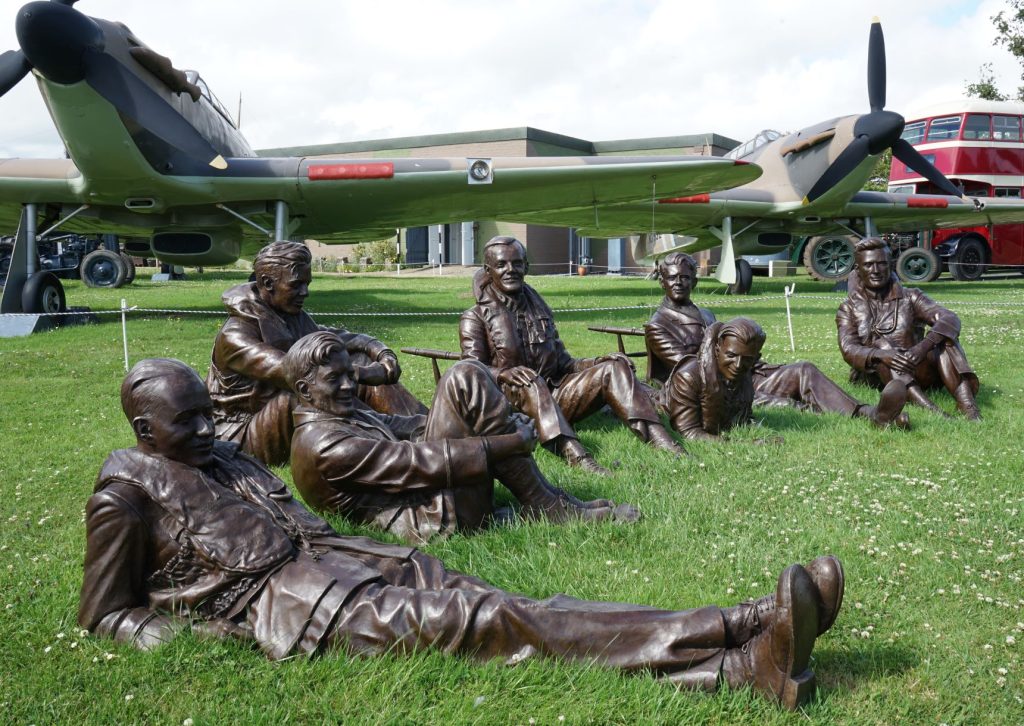
The sculpture is based on a photograph taken at Hawkinge on 29th January 1940, not far from where the memorial now stands. The airmen, Hurricane pilots from No. 32 Squadron, are (from right to left): Pilot Officer Rupert Smythe, 24; Pilot Officer John Proctor, 27; Pilot Officer Keith Gillman, 19; Flight Lieutenant Peter Brothers, 22; Pilot Officer Peter Gardner, 22; Pilot Officer Douglas Grice, 21; Pilot Officer Alan Eckford, 21.5. All but P/O Gillman survived the war.
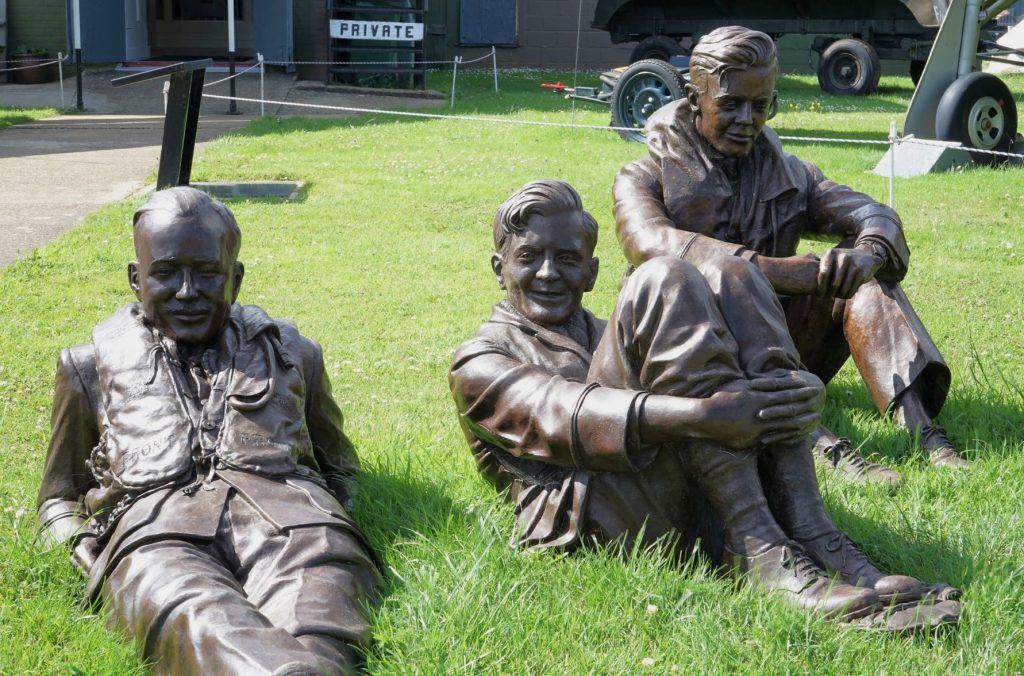

Pilot officer Keith Reginald Gillman was born in Dover, and joined the RAF in March 1939. During the Battle of Britain, he flew Hurricanes with No. 32 Squadron, claiming an aerial victory on July 19th. On August 25th he failed to return from combat off Dover, aged 19.13
Later in my visit, one of the Museum volunteers told me that on the day of the unveiling of the monument, July 29th 2022, each of the sculptures was draped in the RAF flag. Family members of the airmen depicted were there to reveal the statues, and four Hurricanes performed a fly past as part of the ceremonies.
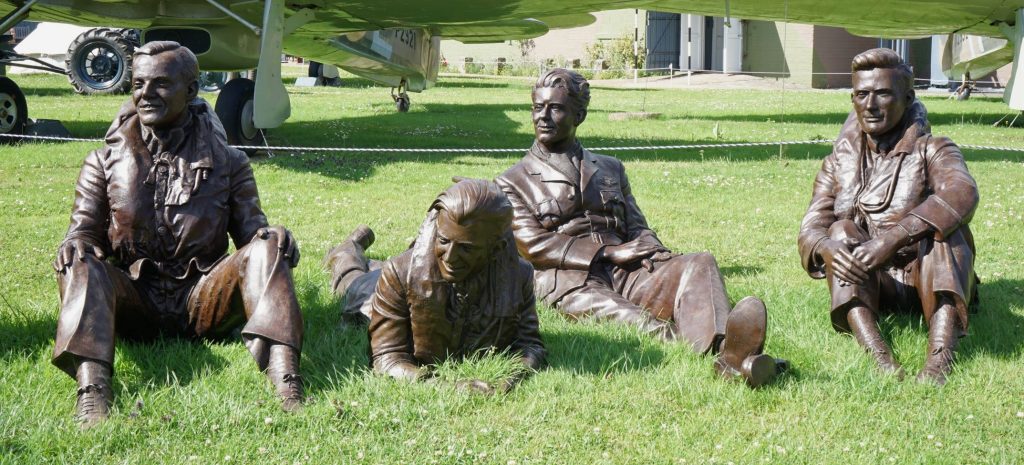
The smiling faces of the young pilots, taking a moment to relax in the summer sun, is a very personal and evocative tribute to those who risked, and those who gave, everything.
Beside RAF Hawkinge’s original Operations Block building sat the remains of two airframes, representing two of the types flown during the Battle of Britain.
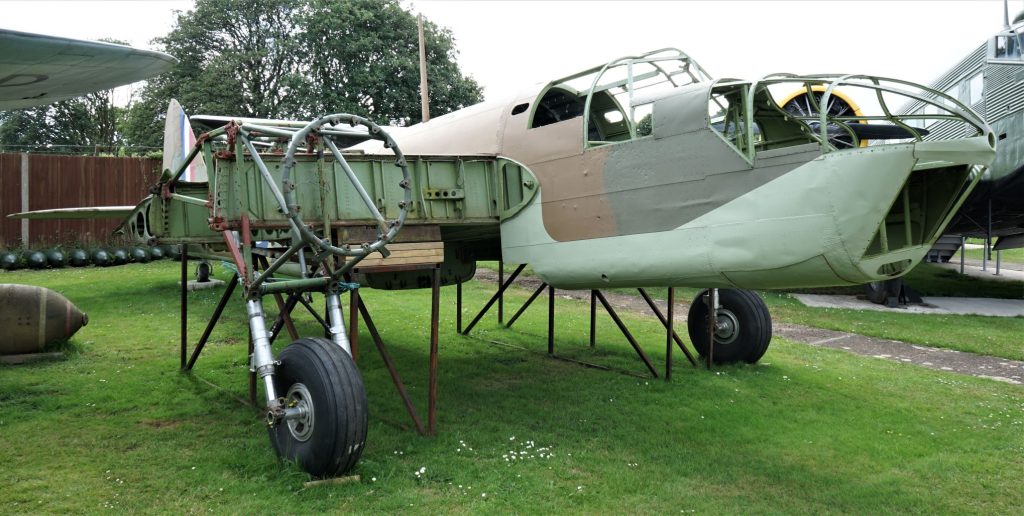
The Museum is building a Bristol Blenheim Mk IV from the remains of four Canadian Bristol Bolingbrokes
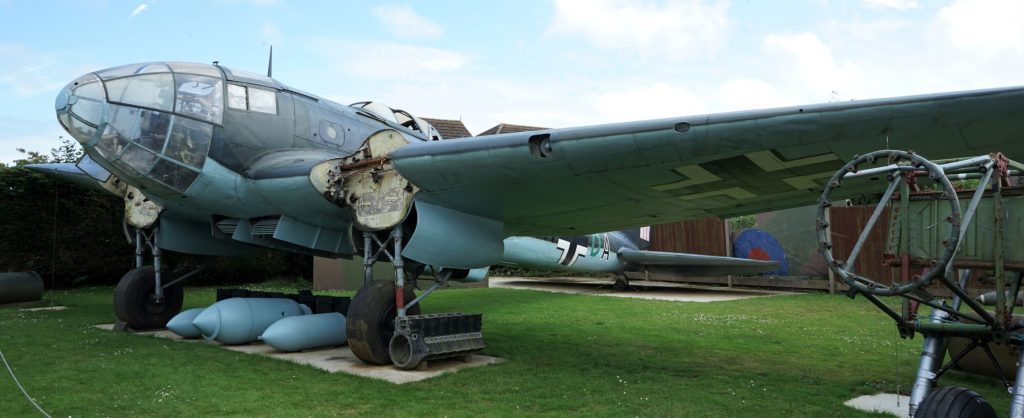
It was mid-afternoon by the time I entered the Operations Block, and there was far more information inside than I had the time, or the capacity, to absorb. All available space was packed tight with displays of wreckage and artefacts recovered from Battle of Britain crash sites. In one corner of the building, guided by Museum signs, I looked up and could see damage to the ceiling sustained during Luftwaffe attacks on the airfield.
Mindful of the time, I moved through the displays and on to Hawkinge’s original Armoury building. Inside was a vast collection of weapons, uniforms and aviation art. By now I had well and truly realised that one day at the Kent Battle of Britain Museum was no-where near enough. In fact, each of the buildings within the complex held enough material to be considered a stand-alone Museum in itself. Nearing closing time, I left the Armoury, walking past a small garden of poppies as I made my way to the Museum exit.
When Churchill spoke of ‘so many’ and ‘so few’, he was, or course, speaking in relative terms. In a way, the well-known title given to the Allied pilots who flew in the Battle of Britain obscures the fact that 2938 airmen is no insignificant number. Nearly three thousand men, each with their own personal story, each part of a family and a community. The Kent Battle of Britain Museum’s extensive collection was a poignant reminder of the scale of the service done and sacrifices made in the summer of 1940.
The following day, I would head east of historic RAF Hawkinge to continue my search for The Few, high on the cliff-tops that witnessed so much of the Battle of Britain.
A couple of tips for visiting the Kent Battle of Britain Museum, Hawkinge
- As mentioned, the Museum’s collection is vast, and the written information provided is extensive. If you have a general interest in the Battle of Britain, I have no doubt you will enjoy a few hours, or a day, at the Museum. However, if you have a deep interest in the Battle, you will very likely need to visit over multiple days.
- Due to the Museum’s regulations, it’s not possible to take photos of information displayed in the Museum. However, take along a notebook and pen when you visit. You can make a few brief notes on things of particular interest, then later search the Museum’s website and Facebook page to find more of the information.
1Kent Battle of Britain Museum, 2024, ‘Former RAF Station, Hawkinge’, Hawkinge
2Phelphs, M., 2024, ‘Last Known Battle of Britain Pilot reached 105 years of age‘, AVweb
3Page, C, and Tate, N, 2023, ‘Battle of Britain: Pilot John Hemingway says he was lucky to survive war’, BBC
4Bentley Priory Museum, ‘The Few: Battle of Britain Aircrew’
5Kent Battle of Britain Museum, Hawkinge
6Hillingdon London, 2024, ‘Flying Officer Franciszek Gruszka’, London
7Metropolitan Police Polish Association, 2020, ‘In Memory of My Great Uncle’
8Imperial War Museums, 2024, ‘Squadron Leader C B Hull’
9Weller, G, 2021, ‘FLLTLT Richard ‘Dickie’ Carew Reynell‘, Air Force Association
10Kayll, J.R., 1940, ‘Report on Hurricane L1584’ cited in Medhurst, A, 2022, ‘Pilot Officer Michael Mudie – whose last combat was broadcast by BBC Journalist Charles Gardner’, Battle of Britain Tours
11Adams, T., ‘Pilot Officer (Pilot) Michael Robert Mudie’, Kenley Revival
12Meanwell, D., ‘Kenley’s Few – Edward James ‘Eddy’ Egan’, Kenley Revival
13The Battle of Britain London Monument, 2007, ‘The Airmen’s Stories – P/O K R Gillman’
Spitfire silhouette sourced from Bob Comix, Hurricane silhouette sourced from creazilla
If you enjoyed this post, you may also like Searching For The Few Part I and Part II
Leave a Reply